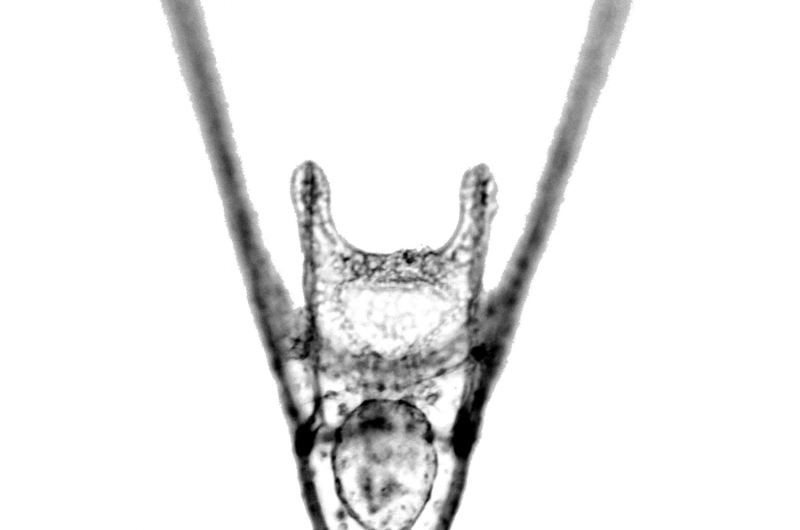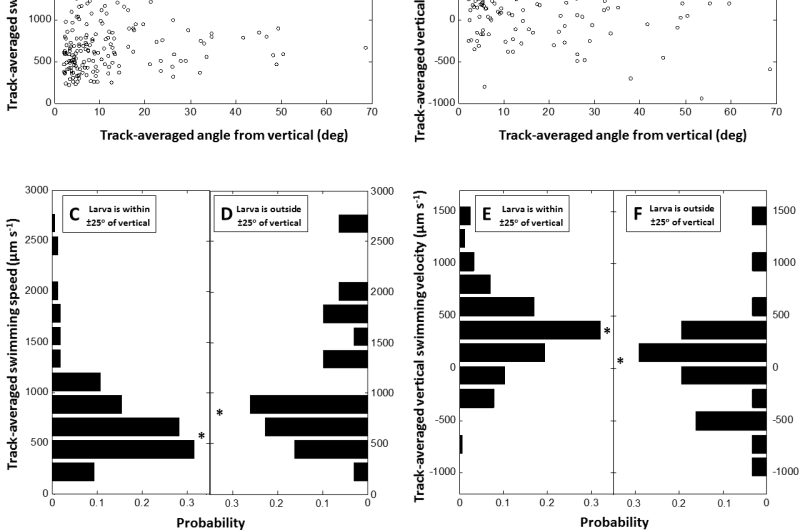Four-armed larva of sea urchin used in the research. Credit: Division of Life Science, HKUST
Many marine invertebrates have complex life histories in which the planktonic larval phase acts as the vehicle to connect otherwise disjointed benthic adult populations which are mostly non-mobile. Larval swimming behaviors in response to various chemical, biological and physical cues have important implications for the adult populations, but to date, most studies on larvae-flow interactions have focused on competent larvae near settlement.
Using larvae of sea urchins as test examples, scientists from HKUST and the Woods Hole Oceanographic Institution found that these little creatures actively modify their swimming speeds in response to ambient flow conditions. They actively increase their swimming speed in increased turbulence and are passively reoriented through morphology-flow interactions, which compromise their ability to maintain directed swimming.
Their findings were published in the latest issue of The Journal of Experimental Biology.
Exposing larval urchins to grid-stirred turbulence, the researchers recorded their behavior at two stages (4- and 6-armed plutei) in three turbulence regimes. Using particle image velocimetry to quantify and subtract local flow, the researchers then tested the hypothesis that larvae respond to turbulence by increasing swimming speed, and that the increase varies with ontogeny. Increased turbulence intensity also decreased the relative time that larvae spent in their typical upright orientation; 6-Armed larvae were tilted more frequently in turbulence compared with 4-armed larvae.
(A,B) Track-averaged orientation angle (0 deg is vertical) versus track-averaged swimming speed (Vs; A) and track-averaged vertical swimming velocity (ws; B). Each point represents an individual 6-armed larva, using larvae from all turbulence regimes. (C-F) Probability distribution of track-averaged swimming speed in upright larvae (within ±25 deg of vertical; C) and tilted larvae (outside ±25 deg of vertical; D), and probability distribution of track-averaged vertical swimming velocity in upright larvae (E) and tilted larvae (F). Asterisks denote median speed or velocity for each distribution. Note that the x-axes for the tilted larvae (D and F) are reversed, so that they are mirror images of C and E, respectively. Credit: Division of Life Science, HKUST
"Larval size and swimming speed increased with ontogeny. This observation suggests that as larvae increase in size and add pairs of arms, they are more likely to be passively re-oriented by moving water, rather than being stabilized (by mechanisms associated with increased mass), potentially leading to differential transport. The positive relationship between swimming speed and larval orientation angle suggests that there was also an active response to tilting in turbulence," said Karen Chan, assistant professor of life sciences at HKUST and one of the co-authors in the study.
"Marine invertebrate larvae swim in a complex fluid environment, and their responses to hydromechanical signals during their planktonic and near-settlement stages have significant implications for transport, survival and recruitment," said Chan. "Our next step is to explore how these marine invertebrates are able to re-orient themselves after being disoriented by flowing currents. How were they able to do that without a complex nervous system?" Chan beamed.
More information: Jeanette D. Wheeler et al, Ontogenetic changes in larval swimming and orientation of pre-competent sea urchinin turbulence, The Journal of Experimental Biology (2016). DOI: 10.1242/jeb.129502
Journal information: Journal of Experimental Biology
Provided by Hong Kong University of Science and Technology

























